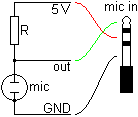Dieter Ziegler from the Robotics department of the Julius-Maximilian University of Würzburg/Germany has greatly contributed to my understanding of electronics, and the design of circuits. Generously, he provided me with various pieces of hardware to perform experiments.
Pleasure in the job puts perfection in the work.
Aristotle
An ordinary computer mouse is a 2D passive manipulator that connects to PC via some interface. The Imeinato device is a 3D passive manipulator that connects to PC via serial port. Applications of such a manipulator include 3-dimensional modelling, but also remote control of machinery. Get an impression at Sensable Technologies.
The manipulator consists of the following mechanical parts: a fairly heavy socket, and three levers (170mm, 88mm, 110mm) connected by hinges. The hinges are potentiometers, which simultaneously serve as voltage dividers. The arrangement draws constant current and divides the supply voltage (5V) linearly depending on the angle.
A micro-controller (ATmega88) with three analog to digital converters (ADC), and a USART interface converts the intermediate voltages of each divider and transmits it to the PC. The update frequency is above > 60 Hz, which is fast enough for many applications. The precision in the coordinates is restricted by the 10-bit (1:1024) resolution of the on-chip ADC.
Tapio Leppänen has engineered the three cylinders, that attach a lever to a rod of a potentiometer.
Formality... Ritual... You should be informed.
Kosh Naranek

The circuit shows how to build a microphone, that connects to the mic-input of the sound-card. The components used are
The microphone capsule consists of a diaphragm, an electret film, and a field effect transistor. The diaphragm resonates with the ambient sound. The oscillations alter the electret film, which in return applies a varying potential to the base of the field effect transistor. This determines the current through the transistor.
The sound-card supplies the circuit with 5V. Depending on the current through the transistor, the voltage across R, and the mic varies. According to my experience, the value R = 10 kΩ gives the best result.
A capacitor with high capacitance in the out-line would prevent DC current flowing into the out connection, and at the same time minimize damping of low-frequencies. However, probably the sound card circuit is protected anyways, and an intermediate capacitor in the out-line deteriorates the sound quality noticeably.
But remember this, my brother
See in this some higher plan
You must use this precious silver
To become an honest man
Start of Libertto